The Influence of the Frequency of Ultrasound on the Exhaust Gas Purification Process in a Diesel Car Muffler
Abstract
:1. Introduction
- -
- Cleaning dust from thermal power plant ash in an ash collection unit;
- -
- Dust from industrial premises.
2. Materials and Methods
2.1. Modeling of Purification of Waste Gases Using the Ultrasonic Method
2.2. Materials
2.3. Methods
- Inlet pipe 32 mm in diameter (1);
- Muffler body 1000 mm in length and 110 mm in diameter (2);
- Laser for determining gas density, DC240 (Xerox, New York, NY, USA) (3);
- DC 12 V power supply AO-777 (Huan Qi, Renqiu, China) (4);
- Temperature sensor TA-298 (D-TEC, Beijing, China) (5);
- Humidity meter TA-298 (D-TEC, Beijing, China) (6);
- Ultrasonic generator X-DG1 (FanYingSonic, Beijing, China) (7);
- Outlet pipe with a diameter of 32 mm (8);
- Longitudinal ultrasonic emitter Transducer (Ultrasonic Cleaning Trans, Guangzhou, China) (9);
- Hygrometer thermometer TA-298 (D-TEC, Beijing, China) (10);
- Removable tray (11);
- Microscope Micmed 2.0 (Micromed, Saint Petersburg, Russia) (12);
- Longitudinal ultrasonic waves (13).
3. Results and Discussion
- -
- Changing the frequency ω leads to changing the pressure in the muffler;
- -
- The pressure change is fixed by the pressure sensor, and the signal from it is transmitted to the ultrasonic generator;
- -
- The frequency f changes while maintaining a constant ratio f/ω.
4. Conclusions
Author Contributions
Funding
Institutional Review Board Statement
Informed Consent Statement
Data Availability Statement
Acknowledgments
Conflicts of Interest
References
- Asaduzzaman, M.; Ali, M.H.; Pratik, N.A.; Lubaba, N. Exhaust heat harvesting of automotive engine using thermoelectric generation technology. Energy Convers. Manag. X 2023, 19, 100398. [Google Scholar] [CrossRef]
- Bönnen, D.; Bamdad-Soufi, D.; Steinkilberg, H.; Abram, K. Possibilities and Constraints for Lightweight in Exhaust Systems. In Proceedings of the 8th International Styrian Noise, Vibration, Harshness Congress (ISNVH), Graz, Austria, 2–4 July 2014; pp. 81–97. [Google Scholar]
- Huang, L.; Simon, T.; Zhang, M.; Yeom, T.; North, M.; Cui, T.H. Noise Measurements and Reduction for High-Frequency Vibrating Devices in the Application of Cooling Electronics. In Proceedings of the ASME International Mechanical Engineering Congress and Exposition, Houston, TX, USA, 9–15 November 2012; pp. 1497–1504. [Google Scholar]
- Kang, I.S.; Yang, S.M. Effect of Confluence Geometry of Dual Exhaust System on Quietness and Power. Int. J. Automot. Technol. 2021, 22, 27–36. [Google Scholar] [CrossRef]
- Lin, T.-H.; Deng, J.; Chen, Y.-C. Using Response Surface for Searching the Nearly Optimal Parameters Combination of the Foam Concrete Muffler. Materials 2022, 15, 8128. [Google Scholar] [CrossRef] [PubMed]
- Pereira, R.L.; Lopes, H.N.; Moura, M.S.; Pavanello, R. Multi-domain acoustic topology optimization based on the BESO approach: Applications on the design of multi-phase material mufflers. Struct. Multidiscip. Optim. 2023, 66, 25. [Google Scholar] [CrossRef]
- Singh, A.K.; Gupta, A.; Kannan, C. Design and Optimization of a Performance Muffler for a Formula SAE Vehicle. SAE Int. J. Engines 2021, 14, 235–245. [Google Scholar] [CrossRef]
- Yan, T.P. The Research of Vehicle Emissions Control New Technology. In Proceedings of the International Conference on Mechatronics, Robotics and Automation (ICMRA 2013), Guangzhou, China, 13–14 June 2013; pp. 2183–2186. [Google Scholar]
- Kim, H.-S. Effect of exhaust manifold geometry and engine parameters on flow pulsations inside the exhaust system with CCC under firing conditions. J. Mech. Sci. Technol. 2021, 35, 805–813. [Google Scholar] [CrossRef]
- Kliewe, P.; Laurain, A.; Schmidt, K. Shape optimization in acoustic–structure interaction. Eng. Comput. 2022, 39, 172–200. [Google Scholar] [CrossRef]
- Pascale, A.; Mancini, S.; Fernandes, P.; Coelho, M.C.; Guarnaccia, C. Single vehicles’ noise emission curves analysis by means of first and second derivatives. Appl. Acoust. 2023, 211, 14. [Google Scholar] [CrossRef]
- Shi, Q.Q.; Yang, Y.Z.; Zhao, Z.; An, B.W.; Tian, P.Y.; Jiang, C.C.; Deng, K.; Jia, H.; Yang, J. Research and design of broadband muffler based on second-order Helmholtz resonators. In Proceedings of the 3rd International Conference on Machinery, Materials Science and Engineering Applications (MMSE 2013), Wuhan, China, 20–21 June 2013; p. 35. [Google Scholar]
- Zhang, J.; Luo, J.; Fu, A.; Zhang, G.; Yang, D. Minimization of noise annoyance from exhaust-system tailpipes through acoustic signal analysis. Appl. Acoust. 2023, 214, 9. [Google Scholar] [CrossRef]
- Xiao, S.; Cheng, S. Research on noise control of automobile exhaust system under idling condition based on modal analysis. Adv. Mech. Eng. 2023, 15, 17. [Google Scholar] [CrossRef]
- Agudelo, A.F.; García-Contreras, R.; Agudelo, J.R.; Armas, O. Potential for exhaust gas energy recovery in a diesel passenger car under European driving cycle. Appl. Energy 2016, 174, 201–212. [Google Scholar] [CrossRef]
- Xie, J.L. Research on Integration Design of Automobile Waste Heat Thermoelectric Generation Exchanger and Engine Muffler. Appl. Mech. Mater. 2014, 494–495, 51–54. [Google Scholar] [CrossRef]
- Guther, T.; Bönicke, H.; Ament, C.; Augustin, S.; Fröhlich, T. A model-based temperature estimator for improving sensor dynamics in vehicle exhaust systems. In Proceedings of the 39th Annual Conference of the IEEE Industrial-Electronics-Society (IECON), Vienna, Austria, 10–14 November 2013; pp. 3852–3857. [Google Scholar]
- Shi, D.; Wang, Y.; Peng, H. Finite element and experimental analysis of pinion bracket-assembly of three gorges project ship lift. J. Cent. South Univ. 2015, 22, 1307–1314. [Google Scholar] [CrossRef]
- Shi, Q.; Yang, Y.Z.; Mei, Z.J.; Lin, Y.Y.; Li, X.Y.; Tian, P.Y.; Kong, P.; Jia, H.; Yang, J.; Deng, K. Design and demonstration of composite mufflers based on dissipative and reactive units. Eng. Res. Express 2023, 5, 11. [Google Scholar] [CrossRef]
- Giechaskiel, B.; Melas, A.; Martini, G.; Dilara, P. Overview of Vehicle Exhaust Particle Number Regulations. Processes 2021, 9, 2216. [Google Scholar] [CrossRef]
- Folkson, R. Alternative Fuels and Advanced Vehicle Technologies for Improved Environmental Performance towards Zero Carbon Transportation Introduction; Woodhead Publishing Series in Energy; Woodhead Publ. Ltd.: Cambridge, UK, 2014; pp. 1–15. [Google Scholar]
- Rojan, M.A.; Alias, Z.; Bakar, S.A.; Hashim, S. Enhancement of MODENAS CT115’S motorcycle muffler performance by optimization of backpressure. In Proceedings of the 6th International Conference on Applications and Design in Mechanical Engineering (ICADME), Penang, Malaysia, 26–27 August 2019. [Google Scholar]
- Nurkusheva, S.; Bembenek, M.; Berdychowski, M.; Gajdzik, B.; Wolniak, R. An Analysis of the Correct Frequency of the Service Inspections of German Passenger Cars—A Case Study on Kazakhstan and Poland. Vehicles 2024, 6, 553–570. [Google Scholar] [CrossRef]
- Donghui, X.; Lin, L.Y.; Jingfeng, D. Experimental Study of Automotive Gasoline Engine Exhaust Gas Recirculation. In Proceedings of the 2013 Fourth International Conference on Digital Manufacturing & Automation, Qingdao, China, 29–30 June 2013; IEEE: Piscataway, NJ, USA, 2013; pp. 575–581. [Google Scholar]
- Oak Ridge National Laboratory for the U.S. Department of Energy and the U.S. Environmental Protection Agency. Available online: https://www.fueleconomy.gov/feg/climate.shtml (accessed on 27 May 2024).
- EDGAR—2023 Emissions Database for Global Atmospheric Research; European Commission: Ispra, Italy, 2023.
- Yadav, J.; Deppenkemper, K.; Pischinger, S. Impact of renewable fuels on heavy-duty engine performance and emissions. Energy Rep. 2023, 9, 1977–1989. [Google Scholar] [CrossRef]
- Chlebnikovas, I.; Jasevičius, R. Air Pollution with Fine Particles in Closed Parking and Theoretical Studies of the Interaction of Inhaled Particles in Respiratory Tract. Buildings 2022, 12, 1696. [Google Scholar] [CrossRef]
- Kim, S.; Dominici, F.; Buckley, T. Concentrations of vehicle-related air pollutants in an urban parking garage. Environ. Res. 2007, 105, 291–299. [Google Scholar] [CrossRef]
- Akgunduz, A.; Kazerooni, A. A non-time segmented modeling for air-traffic flow management problem with speed dependent fuel consumption formulation. Comput. Ind. Eng. 2018, 122, 181–188. [Google Scholar] [CrossRef]
- Kilikevičienė, K.; Chlebnikovas, A.; Matijošius, J.; Kilikevičius, A. Investigation of the acoustic agglomeration on ultrafine particles chamber built into the exhaust system of an internal combustion engine from renewable fuel mixture and diesel. Heliyon 2023, 9, 6. [Google Scholar] [CrossRef] [PubMed]
- Cocean, I.; Cocean, A.; Iacomi, F.; Gurlui, S. City water pollution by soot-surface-active agents revealed by FTIR spectroscopy. Appl. Surf. Sci. 2020, 499, 7. [Google Scholar] [CrossRef]
- Rakhmatov, R.; Galevko, V.; Nadareishvili, G.; Zuzov, V. Improvement of acoustic features of catalytic mufflers. Akustika 2021, 39, 232–236. [Google Scholar] [CrossRef]
- Arjunan, A.; Baroutaji, A. Sound pressure level of a Formula 3 car and the influence of detachable muffler-tip. Results Eng. 2021, 11, 8. [Google Scholar] [CrossRef]
- Lee, J.H.; Lee, H.J.; Sunwoo, M. Nonlinear sliding mode observer for exhaust manifold pressure estimation in a light-duty diesel engine. Int. J. Automot. Technol. 2014, 15, 377–386. [Google Scholar] [CrossRef]
- Liu, F.; Sun, C.H.; Li, Y.K.; Shang, Y. Performance Analysis and Optimization Design of Exhaust System for Turbocharging Diesel Engines. Int. J. Automot. Technol. 2021, 22, 735–745. [Google Scholar] [CrossRef]
- Ibatov, M.K.; Kadyrov, A.S.; Balabaev, O.T.; Askarov, B.S.; Pak, I.A. Device for Ultrasonic Cleaning of Exhaust Gases. RK Patent 3194, 2 October 2017. [Google Scholar]
- Savinykh, Y.A.; Logachev, V.G.; Logachev, S.V.; Vasilyeva, A.Y. Method of Cleaning Exhaust Gas from Particles. Patent RU 2 364 736 C2, 20 August 2009. [Google Scholar]
- Ma, Z.H.; Chen, X.P.; Gao, D.W.; Xu, B. The CFD Analysis of Exhaust Runner for GW15 Gasoline Engine. In Proceedings of the 3rd International Conference on Advances in Materials Manufacturing (ICAMMP 2012), Beihai, China, 22–23 December 2012; p. 326. [Google Scholar]
- Bałon, P.; Cieslik, J.; Halama, L.; Kielbasa, B.; Lach, T.; Lesinski, M.; Lajczak, D.; Rejman, E. A method of manufacturing car mufflers by wrapping sheets, using innovative forming device with the use of servo drive. In Proceedings of the 18th International Conference on Metal Forming, Krakow, Poland, 13–16 September 2020; pp. 17–21. [Google Scholar]
- Chen, F. Optimization design of muffler based on acoustic transfer matrix and genetic algorithm. J. Vibroeng. 2014, 16, 2216–2223. [Google Scholar]
- Kashikar, A.; Suryawanshi, R.; Sonone, N.; Thorat, R.; Savant, S. Development of muffler design and its validation. Appl. Acoust. 2021, 180, 10. [Google Scholar] [CrossRef]
- Wu, C.; Chen, L.; Ni, J.; Xu, J. Modeling and experimental verification of a new muffler based on the theory of quarter-wavelength tube and the Helmholtz muffler. Springerplus 2016, 5, 14. [Google Scholar] [CrossRef]
- Guhan, C.P.; Arthanareeswaren, G.; Varadarajan, K.N. CFD Study on Pressure Drop and Uniformity Index of Three Cylinder LCV Exhaust System. In Proceedings of the International Conference on Computational Heat and Mass Transfer-2015, Warangal, India, 30 November–2 December 2015; pp. 1211–1218. [Google Scholar]
- Shvydkiy, V.S.; Ladygichev, M.G. Gas Purification; Teploenergetik: Moscow, Russian Federation, 2002; 640p. [Google Scholar]
- Baldev, R.; Rajendran, V.; Palanichami, P. Applications of Ultrasound; Technosphere: Moscow, Russia, 2006; ISBN 5-94836-088-1. [Google Scholar]
- Bergman, L. Ultrasound and Its Application in Science and Technology; Publishing House of Foreign Literature: Moscow, Russia, 1957. [Google Scholar]
- Shi, L.M.; Jia, G.H.; Zhang, Z.F.; Xu, Z.M. Analysis and Research of the Combustion Process of YN4100QB Diesel Engine. In Proceedings of the 3rd International Conference on Machinery, Materials Science and Engineering Applications (MMSE 2013), Wuhan, China, 20–21 June 2013; p. 35. [Google Scholar]
- Dong, S.; Lipkens, B.; Cameron, T.V. The effects of orthokinetic collision, acoustic wake and gravity on acoustic agglomeration of polydisperse aerosols. J. Aerosol Sci. 2006, 37, 540–553. [Google Scholar] [CrossRef]
- Breed, D.S. Vehicular Information and Monitoring System and Method. U.S. Patent US7082359B2, 25 July 2006. [Google Scholar]
- Varga, A.J.; Breed, D.S.; Duvall, W.E. Method for Identifying the Presence and Orientation of an Object in a Vehicle. U.S. Patent US5943295A, 25 August 1999. [Google Scholar]
- Kadyrov, A.; Sarsembekov, B.; Ganyukov, A.; Suyunbaev, S.; Sinelnikov, K. Ultrasonic unit for reducing the toxicity of diesel vehicle exhaust gases. Commun.-Sci. Lett. Univ. Žilina 2022, 24, 189–198. [Google Scholar] [CrossRef]


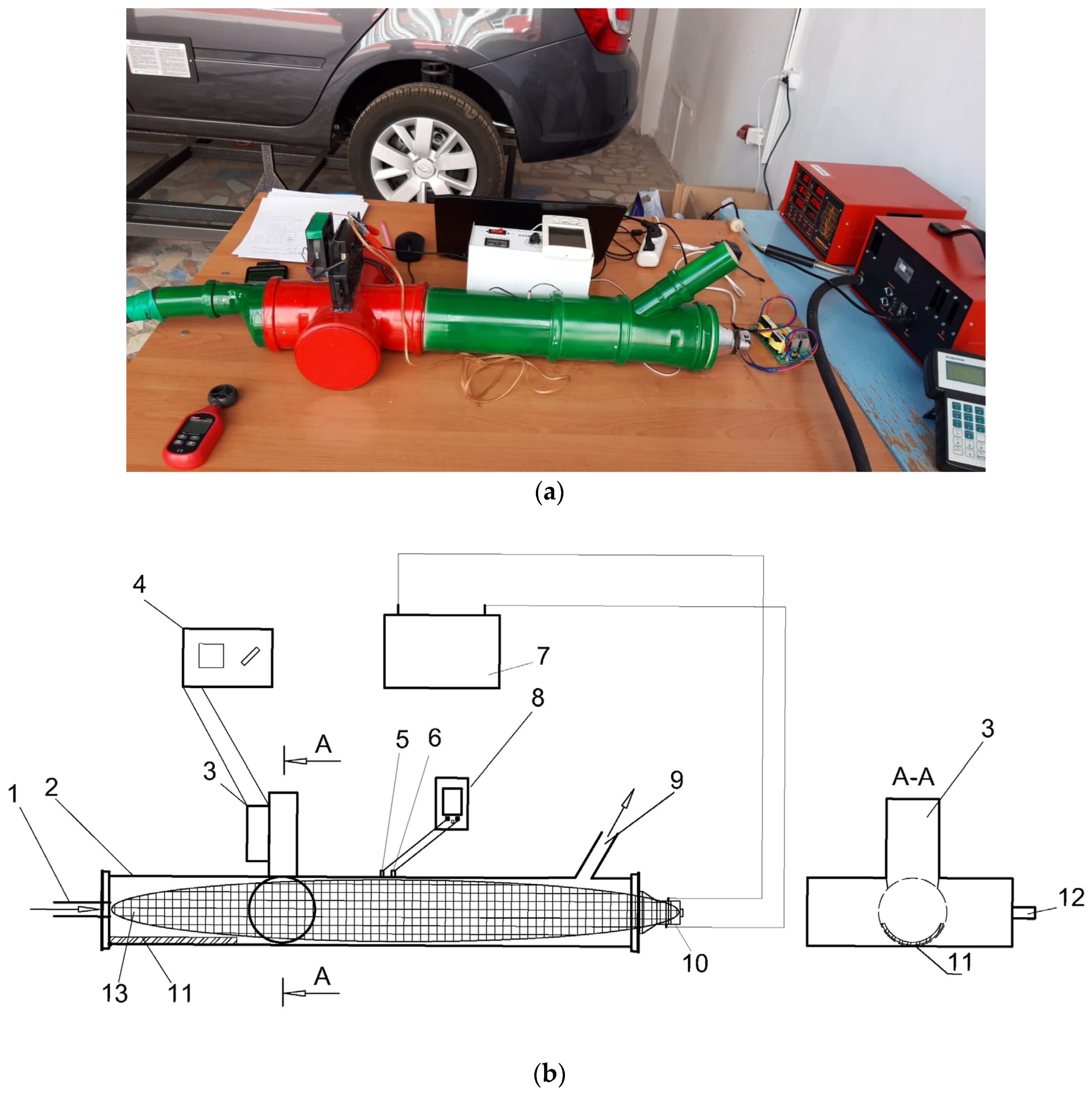
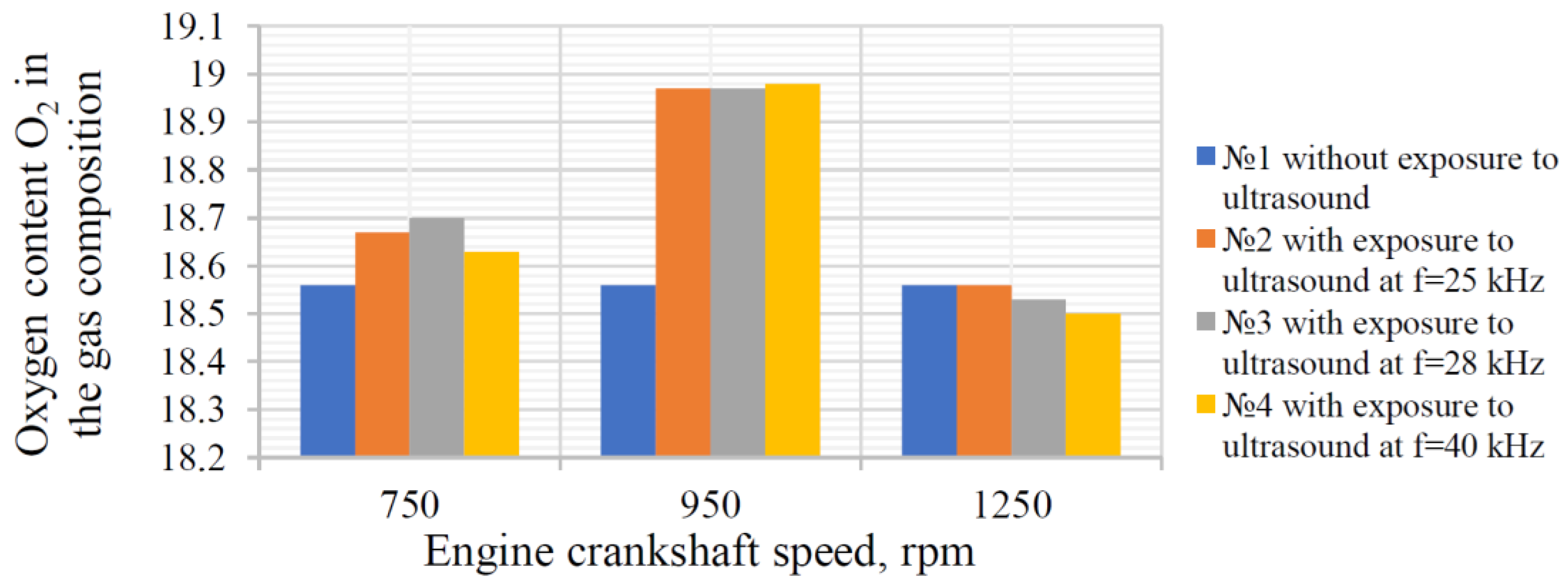
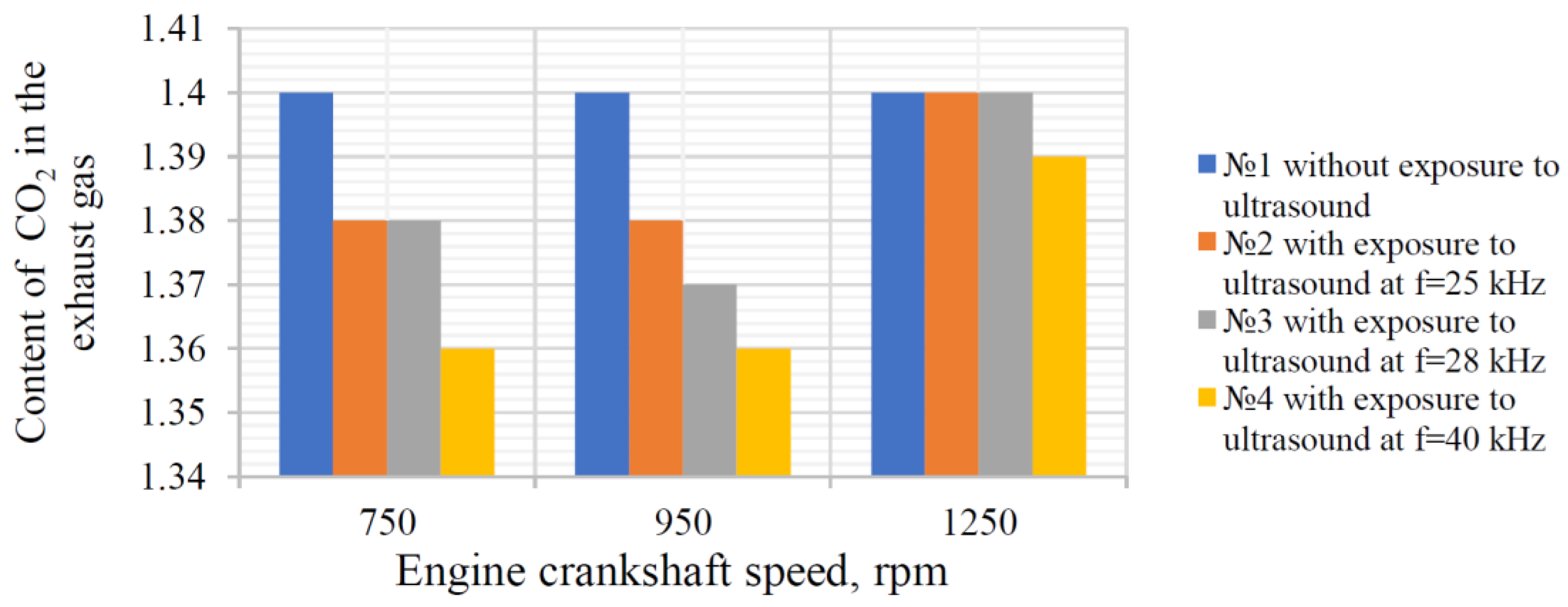

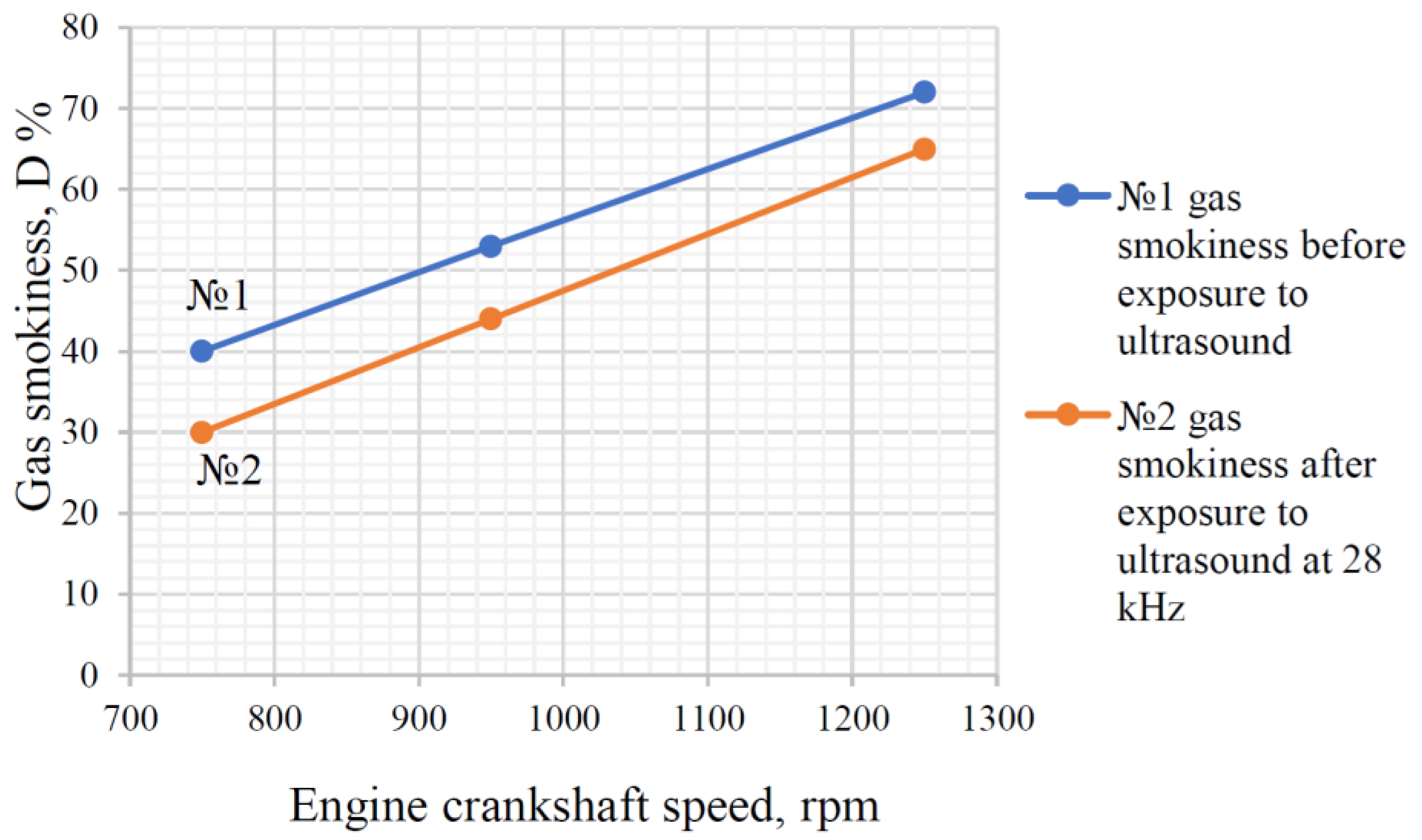
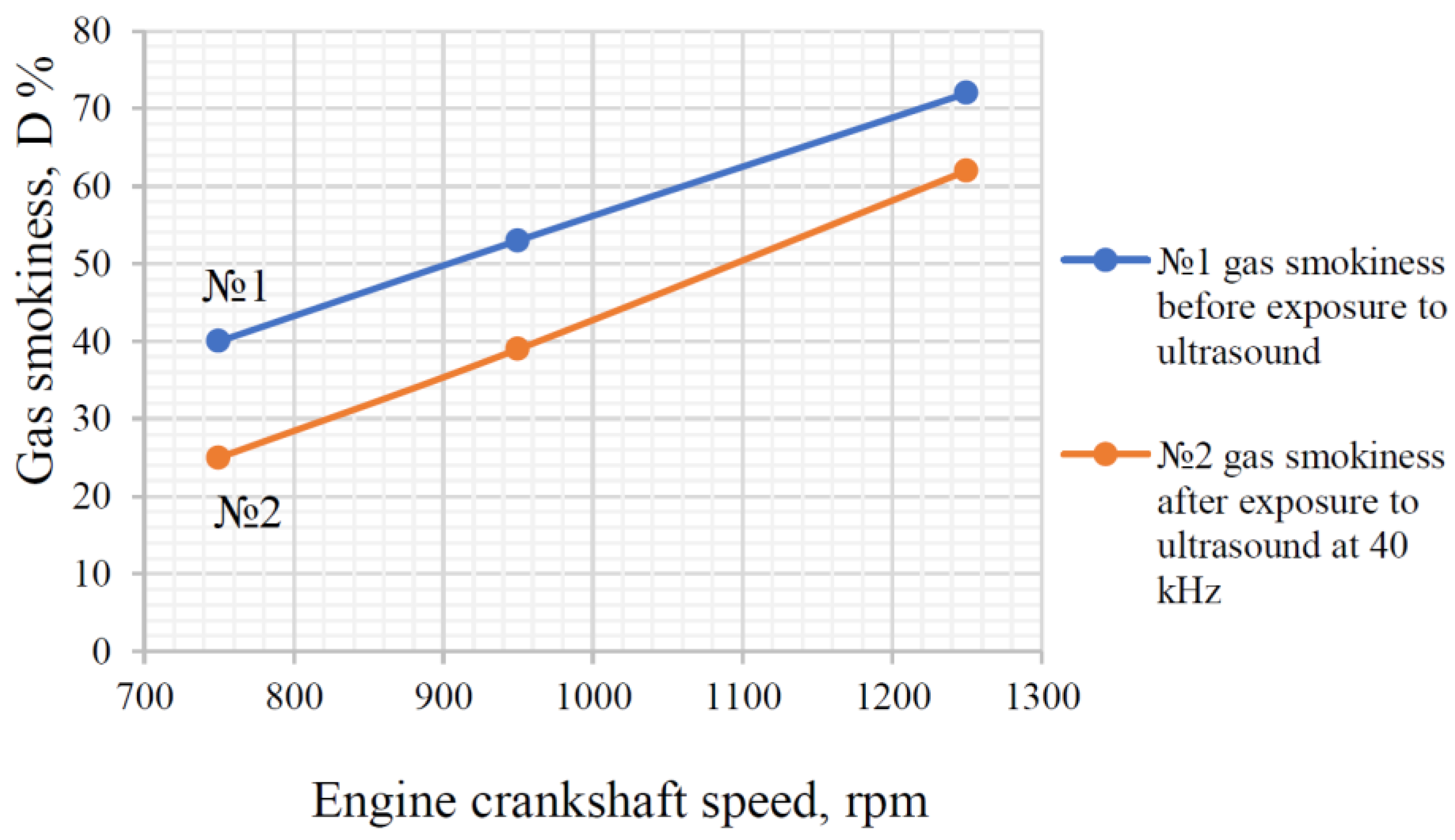
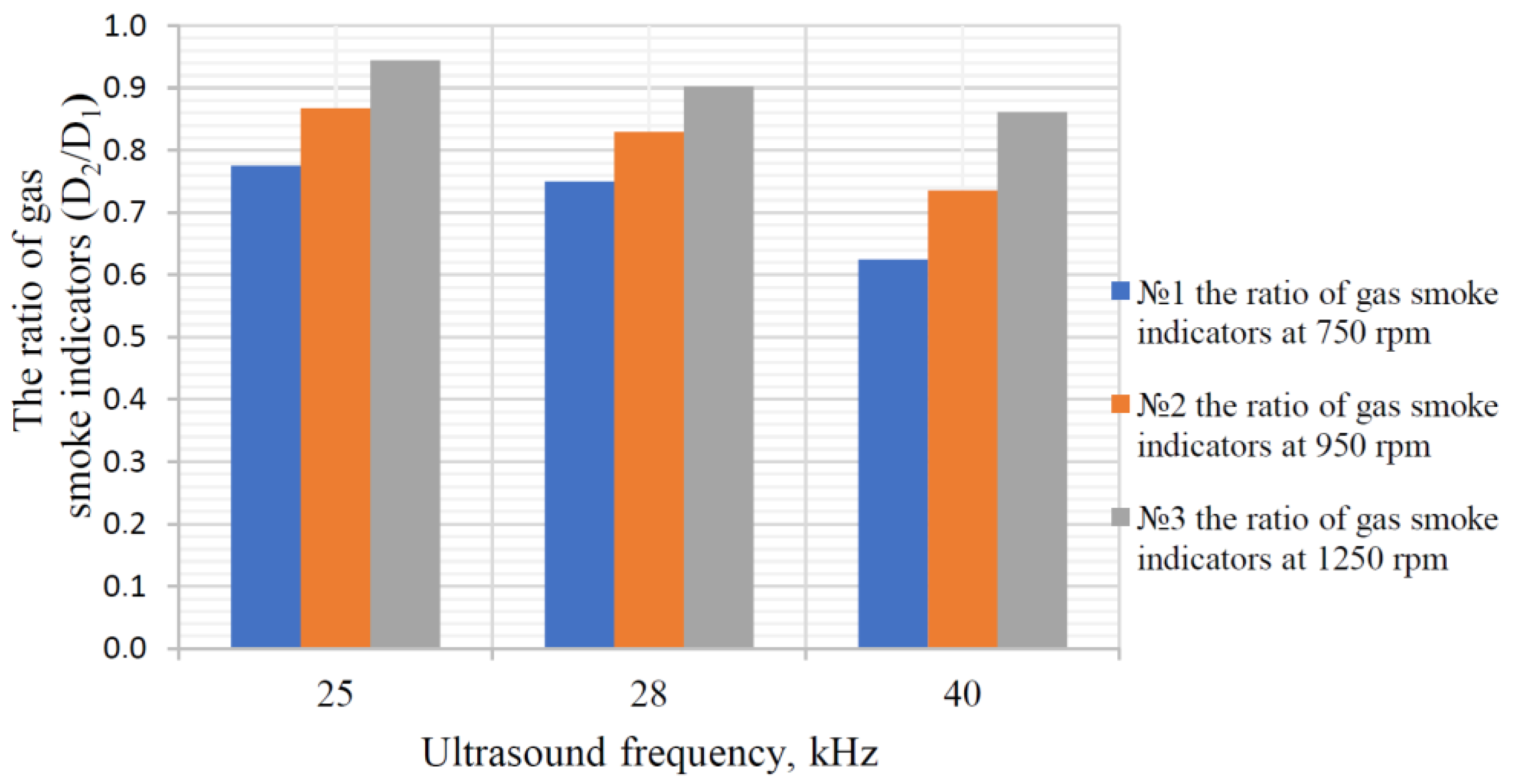
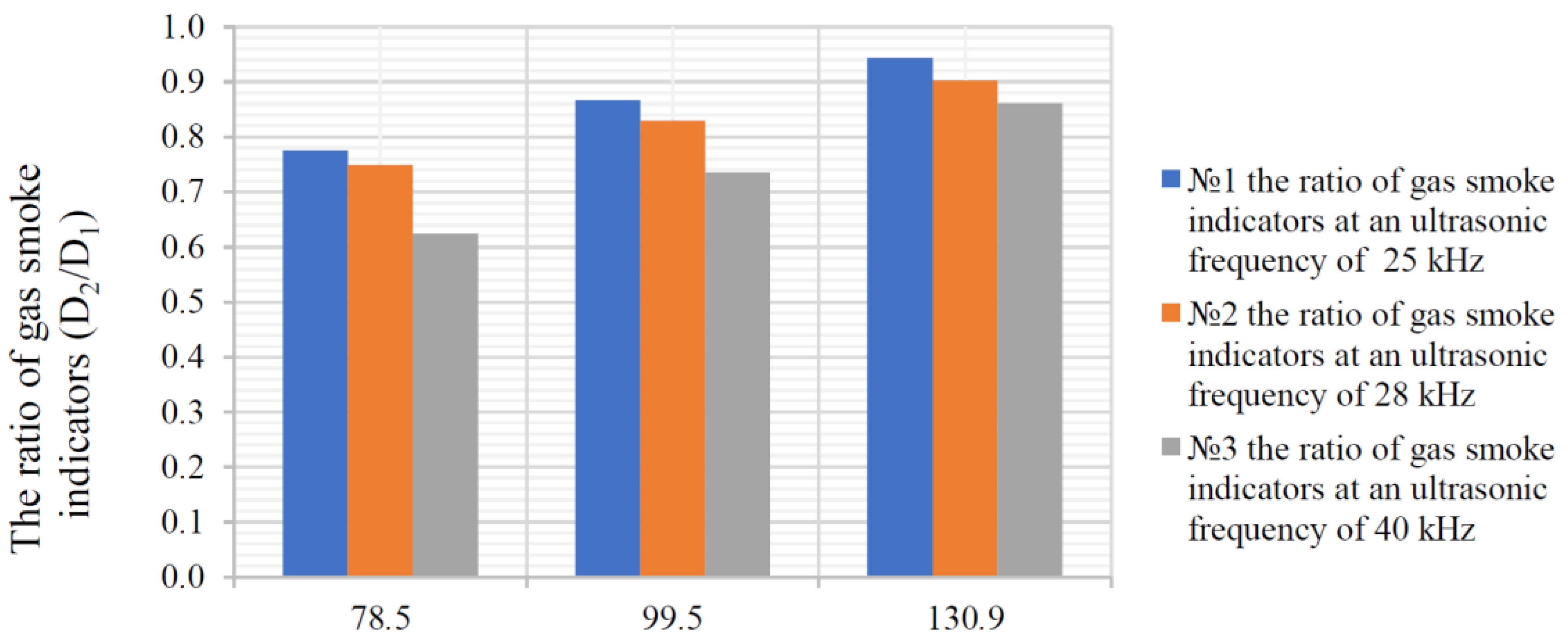
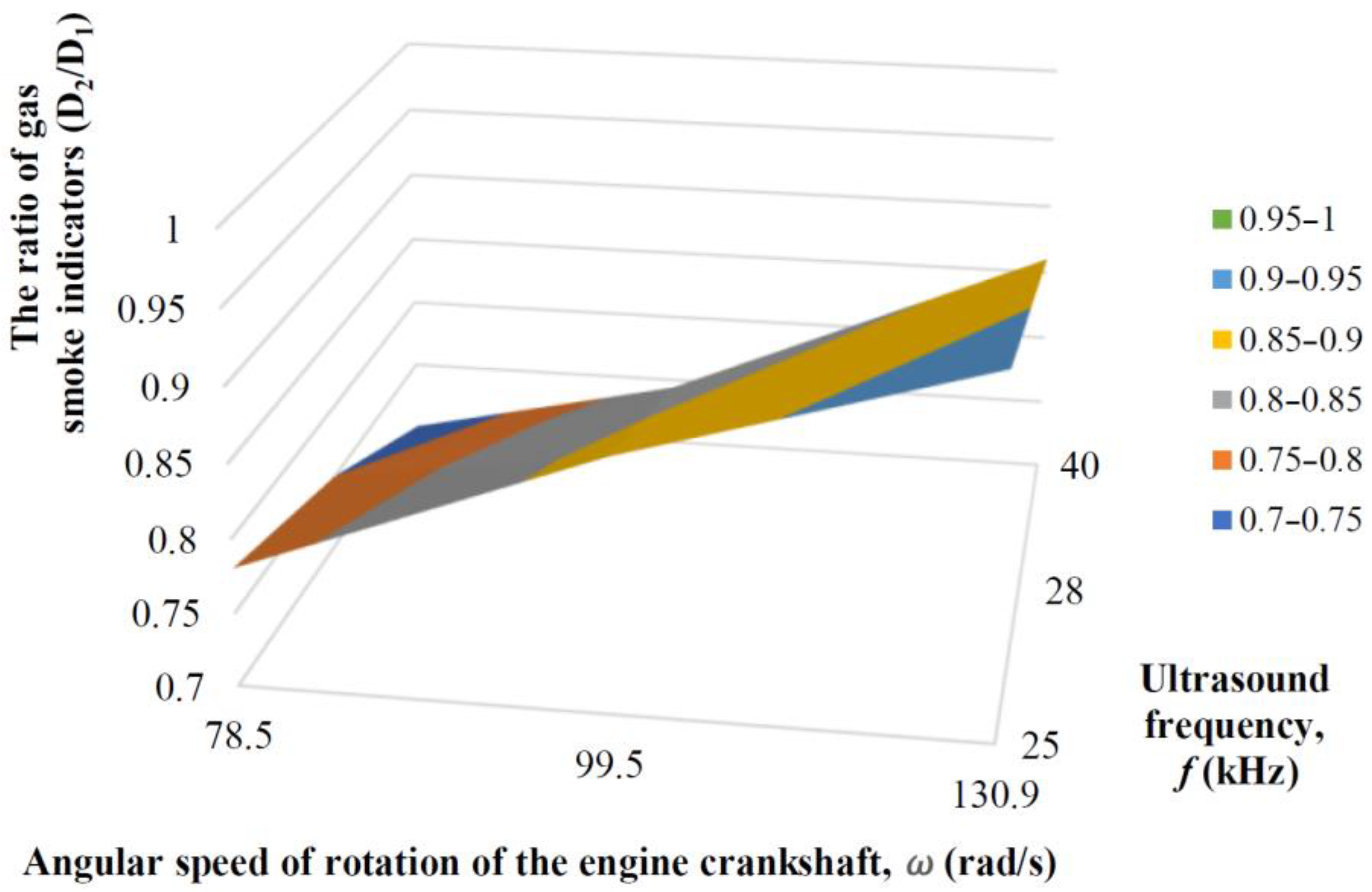
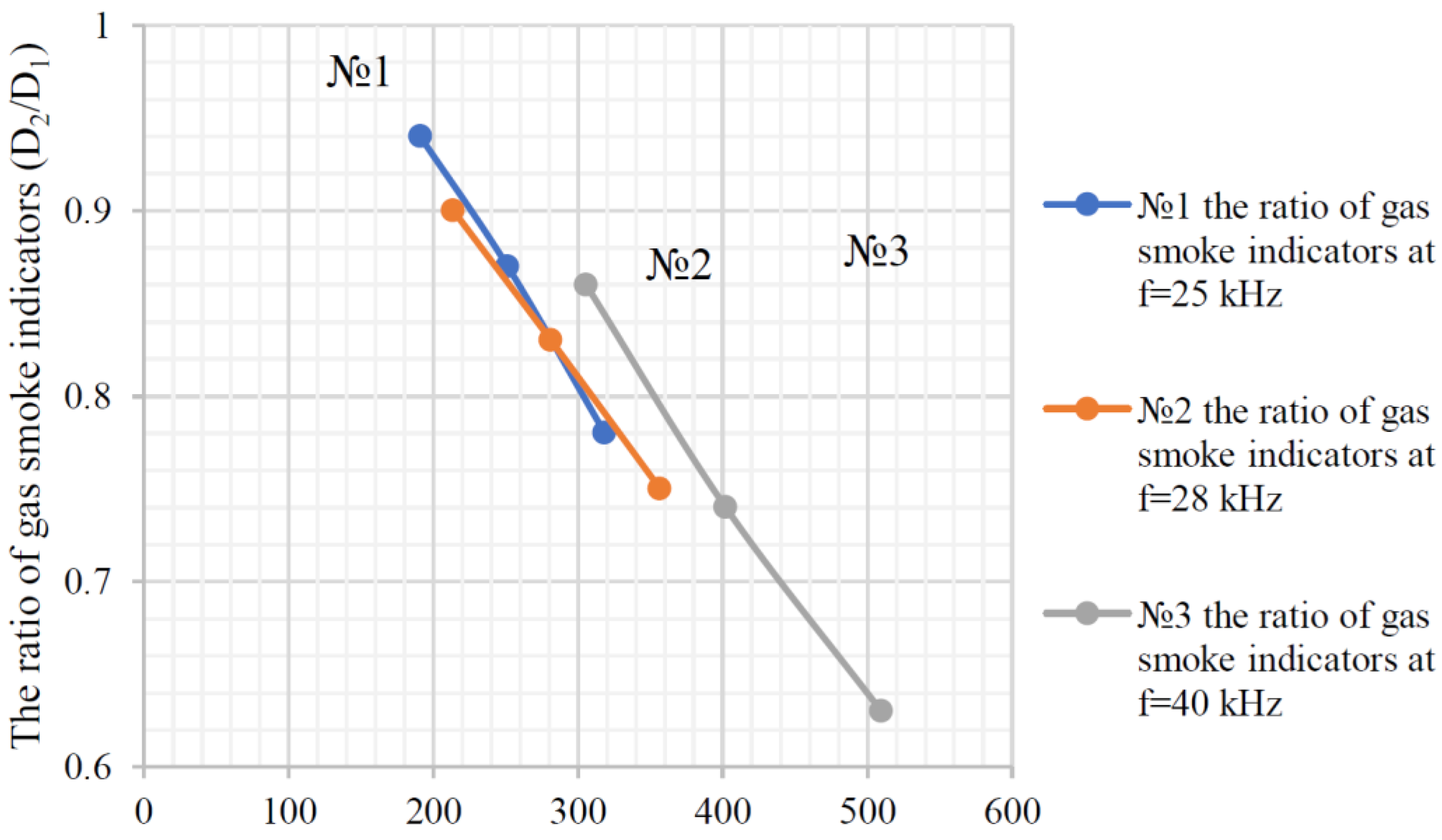
| Parameters | Value |
|---|---|
| Year of manufacturing | 2003 |
| Millage, km | 153,000 |
| Engine capacity, cm3 | 2685 |
| Type of supply fuel | Diesel |
| Engine’s type | In-line, 5-cylinder |
| Supercharger type | Turbine |
| Maximum power, HP (kW) at rpm | 163 (120)/4200 |
| Maximum torque, N·m (kg·m) at rpm | 370 (38)/2800 |
| Number of valves per cylinder | 4 |
| Compression ratio | 18 |
| Cylinder diameter, mm | 88 |
| Piston stroke, mm | 88.3 |
| Additional engine information | DOHC |
| Ecological engine type | Euro-3 |
| Country of assembly | Austria |
| Engine Crankshaft Speed, rpm | O2, % | CO2, % | ||||||
|---|---|---|---|---|---|---|---|---|
| Ultrasound Frequency, kHz | ||||||||
| Without | 25 | 28 | 40 | Without | 25 | 28 | 40 | |
| 750 | 18.56 | 18.67 | 18.70 | 18.63 | 1.40 | 1.38 | 1.38 | 1.36 |
| 950 | 18.56 | 18.97 | 18.97 | 18.98 | 1.40 | 1.38 | 1.37 | 1.36 |
| 1280 | 18.56 | 18.56 | 18.53 | 18.50 | 1.40 | 1.40 | 1.40 | 1.39 |
| Engine Crankshaft Speed, rpm | CO, % | CH, ppm | ||||||
|---|---|---|---|---|---|---|---|---|
| Ultrasound Frequency, kHz | ||||||||
| Without | 25 | 28 | 40 | Without | 25 | 28 | 40 | |
| 750 | 0.02 | 0.02 | 0.02 | 0.01 | 0.02 | 0.00 | 0.00 | 0.00 |
| 950 | 0.02 | 0.02 | 0.02 | 0.02 | 0.02 | 0.00 | 0.00 | 0.00 |
| 1280 | 0.02 | 0.01 | 0.01 | 0.01 | 0.02 | 0.02 | 0.02 | 0.02 |
| Engine Crankshaft Speed, (rpm) | ||||||
|---|---|---|---|---|---|---|
| 750 | 950 | 1250 | ||||
| Smokiness, % | ||||||
| Ultrasound Frequency (kHz) | Without Exposure to Ultrasound | With Exposure to Ultrasound | Without Exposure to Ultrasound | With Exposure to Ultrasound | Without Exposure to Ultrasound | With Exposure to Ultrasound |
| 25 | 40 | 31 | 53 | 46 | 72 | 68 |
| 28 | 40 | 30 | 53 | 44 | 72 | 65 |
| 40 | 40 | 25 | 53 | 39 | 72 | 62 |
| Options | Without Ultrasound | Ultrasound Frequency, kHz | ||
|---|---|---|---|---|
| 25 | 28 | 40 | ||
| Temperature (°C) | 47.6 | 47 | 47.5 | 48 |
| Humidity (%) | 15 | 15 | 15 | 15 |
| Gas speed (m/s) | Input 18 Output 10.3 | Input 18 Output 10.3 | Input 18 Output 10.3 | Input 18 Output 10.3 |
| Engine Crankshaft Speed, rpm | 750 | 950 | 1250 |
|---|---|---|---|
| Ultrasound frequency (kHz) | The ratio of the indicators for the smokiness of the gas (D2/D1) | The ratio of the indicators for the smokiness of the gas (D2/D1) | The ratio of the indicators for the smokiness of the gas (D2/D1) |
| 25 | 0.78 | 0.87 | 0.94 |
| 28 | 0.75 | 0.83 | 0.90 |
| 40 | 0.63 | 0.74 | 0.86 |
| Engine crankshaft speed, rpm | 750 | 950 | 1250 |
| Angular speed of the engine crankshaft ω, rad/s | 78.5 | 99.5 | 130.9 |
| Parameters | Value | ||
|---|---|---|---|
| Angular speed of the engine crankshaft ω, rad/s | 78.5 | 99.5 | 130.9 |
| The ratio of the indicators for the smokiness of the gas (D2/D1) at the ultrasound frequency, kHz | 0.89/25 kHz | 0.95/25 kHz | 0.94/25 kHz |
| 0.9/28 kHz | 0.92/28 kHz | 0.93/28 kHz | |
| 0.87/40 kHz | 0.91/40 kHz | 0.91/40 kHz | |
| The ratio of the ultrasound frequency to the angular rotation speed of the engine crankshaft, f/ω | 318.5 | 251.3 | 190.98 |
| 356.7 | 281.4 | 213.9 | |
| 509.6 | 402.01 | 305.57 | |
Disclaimer/Publisher’s Note: The statements, opinions and data contained in all publications are solely those of the individual author(s) and contributor(s) and not of MDPI and/or the editor(s). MDPI and/or the editor(s) disclaim responsibility for any injury to people or property resulting from any ideas, methods, instructions or products referred to in the content. |
© 2024 by the authors. Licensee MDPI, Basel, Switzerland. This article is an open access article distributed under the terms and conditions of the Creative Commons Attribution (CC BY) license (https://creativecommons.org/licenses/by/4.0/).
Share and Cite
Kadyrov, A.; Bembenek, M.; Sarsembekov, B.; Kukesheva, A.; Nurkusheva, S. The Influence of the Frequency of Ultrasound on the Exhaust Gas Purification Process in a Diesel Car Muffler. Appl. Sci. 2024, 14, 5027. https://doi.org/10.3390/app14125027
Kadyrov A, Bembenek M, Sarsembekov B, Kukesheva A, Nurkusheva S. The Influence of the Frequency of Ultrasound on the Exhaust Gas Purification Process in a Diesel Car Muffler. Applied Sciences. 2024; 14(12):5027. https://doi.org/10.3390/app14125027
Chicago/Turabian StyleKadyrov, Adil, Michał Bembenek, Bauyrzhan Sarsembekov, Aliya Kukesheva, and Saltanat Nurkusheva. 2024. "The Influence of the Frequency of Ultrasound on the Exhaust Gas Purification Process in a Diesel Car Muffler" Applied Sciences 14, no. 12: 5027. https://doi.org/10.3390/app14125027







